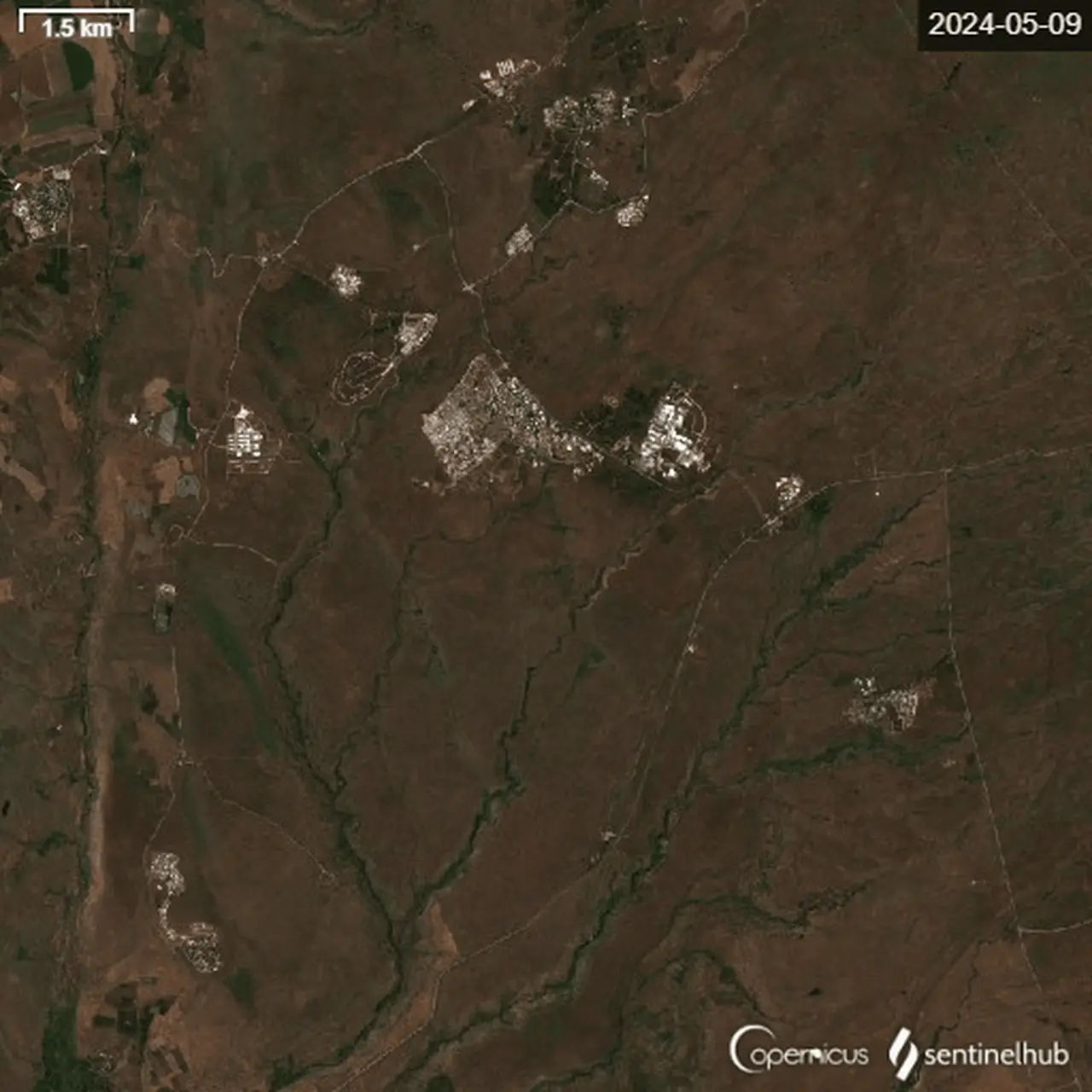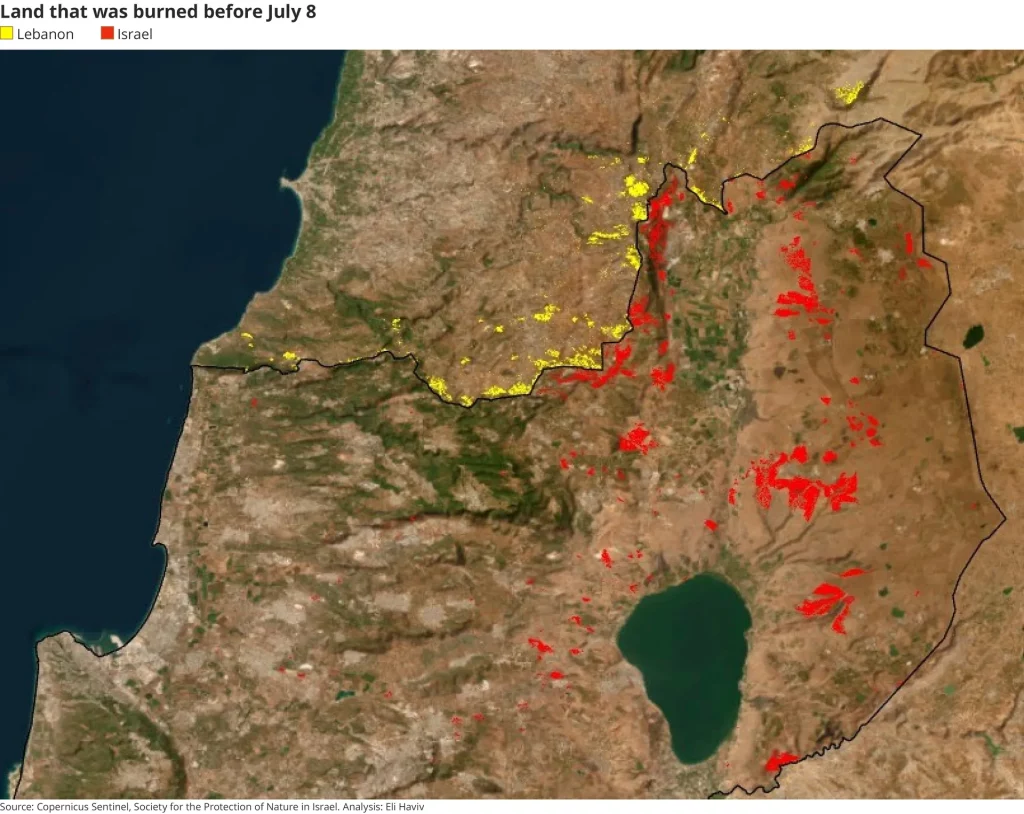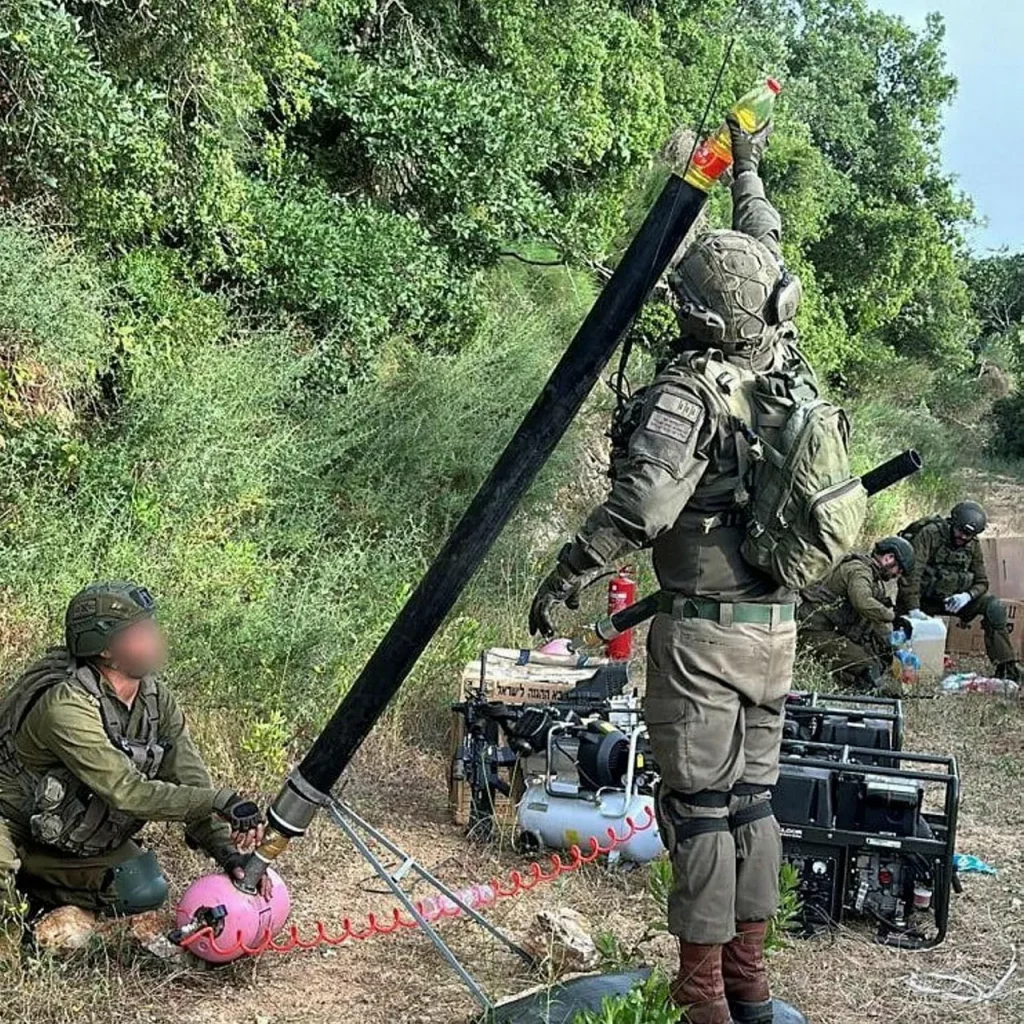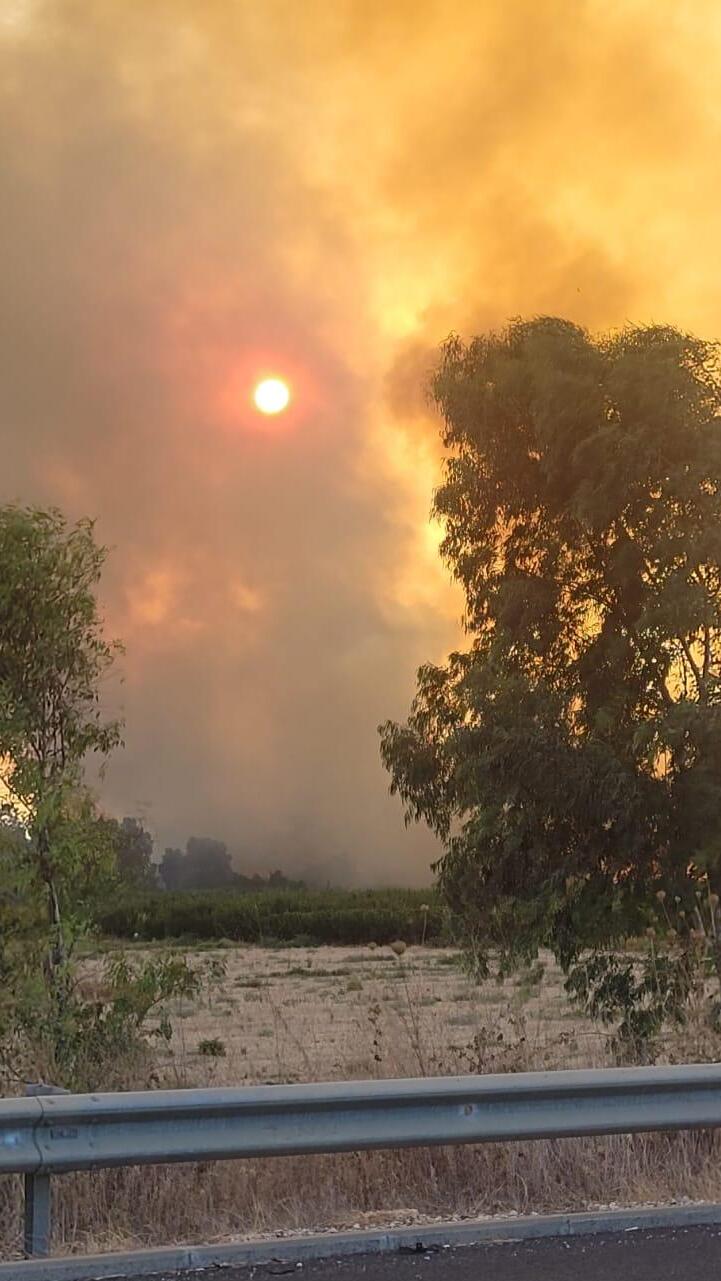Israel and Hezbollah’s ‘War of Fire’: Satellite Images Reveal the Devastating Damage – Haaretz
Bar PelegNir HassonAvi Scharf. Aug 4, 2024
Images indicate that since the outbreak of hostilities – but mainly since May – some 52000 acres have been burned down in Israel and Lebanon. The total scorched area in Israel is three times greater than the area consumed by the two greatest fires in Israeli history
The burned carcasses of cows found in the southern Golan Heights last month was testimony to the intensity of the blaze that raged there. All that remained was a pile of bones by a fence, perhaps a sign that the poor animals were attempting to escape before they died.
A similar sight was discovered in Biriya Forest, where a small herd was consumed by the flames. Members of the local security team arriving at the scene discovered the tragedy. It was probably caused by an interception missile or a rocket. Not far from there, on the Lebanese side of the border, a flare landed and set to fire to everything in its wake. White smoke billowed among the wadis as firefighters struggled to reach the spot.
These images have repeated themselves on both sides of the border since fighting broke out in northern Israel and southern Lebanon last October.
The affected Israeli areas in the north are spread over a large region, while in Lebanon they are concentrated near the border due to an IDF policy of setting fires to try to keep Hezbollah combatants away.

According to a Haaretz analysis of satellite images, which matches with estimates by authorities, some 52,000 acres of land burned down in Israel and Lebanon: about 37,000 acres in Israel from Hezbollah attacks and Israel Defense Forces anti-aircraft fire, and around 15,000 acres in Lebanon
The burned-down areas in Israel stretch over a large area in the Galilee and Golan Heights, while in Lebanon they are concentrated near the border – due to the Israeli military policy of setting deliberate fire to areas there in order to keep Hezbollah combatants away and to damage the vegetation that provides them with cover.
- As northern Israel burns, residents know the state won’t save them
- Vast areas of northern Israel’s forests, burned in the 2006 Lebanon War, burn again
- Why Israel’s north won’t be the same after the Gaza war
“This is currently a demilitarized zone, also from vegetation,” a senior Israeli officer told Haaretz.
The “war of fire” between Israel and Hezbollah has harmed animals, property and land, leaving the area with many scars observable even from space.
One recent fire even licked the edges of a top-secret military base in the north where, according to reports published about a decade ago, Israel has been keeping nuclear weapons. It is unknown whether the base sustained any damage.
The story of blazes being set by the Israeli military near the Lebanon border made the news in June with the release of a video showing Israeli reservists using ancient weapons such as trebuchet and bow and arrow in order to launch burning objects into Lebanon.
The videos quickly went viral on social media and the Israeli military was forced to admit that soldiers were indeed deliberately setting fire to complex fortified areas established by Hezbollah along the border. These included trenches, bunkers, rocket-launching positions and arms storage sites.

Some senior and junior military sources have told Haaretz of the methodical way in which this was done, with the aim of stripping the area where Hezbollah’s elite Radwan Force combatants were staying on the eve of the war.
“This was no coincidence – that was the mission,” a senior reservist officer said. “The northern divisions are on defense duty, not offense duty. Since the war began, security and defense regions have been assigned to every battalion. We call this ‘deadly defense.’ Each force also received cross-border assignments in which it leaves the area facing it clear of vegetation and secured.”
‘We kept thinking about how to burn down the forests around the outpost so the land around the fence is stripped, an Israeli soldier who served on the border told Haaretz.
According to the senior officer, “The understanding is that only when the area is stripped of vegetation will we be able to move on to the next phase of clearing whatever is under the thicket. At first, they said this wasn’t possible; for many years, nobody touched it. It was in fact the insistence of those of us on the ground that turned it into an efficient tool. When the area has been burned down, you can go on a photographic mission and see everything.”
By everything, the officer means the infrastructure constructed by Hezbollah under cover of the thicket.
“The problems that concern the IDF are anti-aircraft fire and an undercover Hezbollah raid using the thicket. They require some barrier zone,” another reservist officer said. “At the end of the day, the IDF wants to create a safe distance that will not allow Hezbollah to make use of the terrain.” On the eve of the war, there were some 2,400 Radwan Force combatants near the border, south of the Litani River. The Israeli military now estimates that a few hundred remain, with many hundreds more situated within 20 kilometers (12 miles) of the border. According to a senior military source, these combatants are ready to go on the offensive at a few hours’ notice.

Shells, drones, improvisations
The UN Convention on Certain Conventional Weapons limits the use of weapons intended to cause fires, and bans their use against civilians, communities and military targets situated within population centers. In addition, the convention also bans setting military targets situated within population centers on fire from the air, unless clearly separated from them. The convention also only allows setting fire to forests where they lend cover to military targets, but only under certain conditions.
Israel is not committed to these rules, as it is only a signatory to the parts of the convention that do not refer to weapons causing fire. Nevertheless, the military believes it still complies with all of them.
The main tools used by the Israeli military to set fire to lands are artillery shells, drones and bombs, alongside improvisations by soldiers such as Molotov cocktails. The military also uses flares, originally intended to shed light on areas but which burn everything they come into contact with when they hit the ground.
The blazes are also indirectly caused by “white smoke” shells, used by the military in the north in order to hamper anti-aircraft fire from southern Lebanon and to assist in evacuating the wounded on the Israeli side.Credit: Hussein Malla/AP

The blazes are also indirectly caused by “white smoke” shells, used by the military in the north in order to hamper anti-aircraft fire from southern Lebanon and to assist in evacuating the wounded on the Israeli side. These shells contain phosphorus-soaked felt pads. These burn upon contact with the air, creating a jellyfish-like image in the sky.
Their first widespread operational use in Israel was during 2008-09’s Operation Cast Lead, and they featured prominently in the UN fact-finding study into that Gaza conflict. In 2009 and 2011, Israel handed in reports to the UN where it said it officially admonished two officers who fired “white smoke” on the Tel al-Hawa neighborhood in southern Gaza City. However, after Haaretz reported on this, the military clarified that the two officers had been admonished not for using phosphorus, but for not following regulations about artillery fire on a populated area.
When “white smoke” shells explode relatively low in the sky, they could cause fire on the ground. However, the military says this is a by-product, not the goal, and that these shells are inefficient in setting fires.
Some videos document blazes in Lebanon caused by “white smoke” shell explosions, but Haaretz found that these fires were not widespread. The Israeli army stresses that not every use of phosphorus is considered illegal – only using it against civilians. Military regulations limit the use of phosphorus in a populated area, but that depends on policy and is not always considered illegal. The army notes that military regulations limit the use of such shells for the creation of a smokescreen.

The Israeli army is also in possession of phosphorus shells, but officers told Haaretz that the military does not use these in the fighting.
In addition to the official weapons, soldiers on the border have also been improvising arson devices. “We kept thinking about how to burn down the forests around the outpost so the land around the fence is stripped,” a soldier who served on the border told Haaretz. In addition to the trebuchet and bow and arrow, use of a mortar-like pipe – with a launcher for Molotov cocktails or gasoline attached to it – was also documented.
“This is how reservists improvise,” said a senior reserve officer who served in the area through months of fighting. Another officer noted that “usually, those improvised methods are less efficient. Burning down green areas in Lebanon is not simple.”
Fires reshaping the landscape
Since the fighting erupted, the total scorched area in Israel is three times greater than the area consumed by the two greatest fires in Israeli history: the Sha’ar Hagai blaze west of Jerusalem in 1995, and the Mount Carmel forest fire in 2010. In each of those blazes, some 5,000 to 6,200 acres of forest went up in smoke.
The total area burnt down now is also three times the combined area incinerated in 2016 when extreme weather conditions caused a wave of fires that consumed some 10,000 acres. A similar size of woodland and forest also burned down during the Second Lebanon War. In 2019, a huge blaze consumed large swaths of central Israel’s Mevo Modi’im community.
In addition to the scope of the fires, Israeli firefighting crews rarely had to deal with blazes caused by rockets until now. This is because the vast majority of open-space blazes in Israel were man-made and so their epicenter was no more than 50 meters (164 feet) from a road, community or camping site, beyond which there is no access to humans. Firefighters could therefore arrive at the heart of the blaze with firefighting vehicles.
Weapons that fall from the sky, however, can cause fires anywhere, even deep in the forest or wood where access is difficult. In that sense, these rocket fires are more like lightning-induced fires.
Another hardship facing the firefighting services is the limitation imposed by the military on using firefighting airplanes near the border. Consequently, firefighting teams often have to work on foot. Meanwhile, in cases where there is danger of enemy fire from Lebanon, firefighters have to abandon blazes that do not endanger communities or people.
Very often, firefighters have to operate in extremely difficult circumstances, protected by helmets and ceramic vests. “Very few countries around the world had to face blazes under enemy fire,” said Fire Deputy Chief Shay Levy, head of the research, open spaces and climate change department in Israel’s Fire and Rescue Service.
The blazes in the north did not start with the outbreak of fighting but in early May, when the winter rains had relented. The hot weather dried up the ground, rendering the forest, woodland and undergrowth areas particularly flammable. As the war has stretched on, fires have become an inseparable part of it, reshaping the landscape in northern Israel.
‘Green Iron Dome’
Eli Haviv, an ecologist with the Society for the Protection of Nature in Israel, analyzed the type of terrain that has burned down in the Galilee and Golan Heights. He found that about 83 percent of it is shrubland and areas of low vegetation that should recover quickly soon after the rains return. Most of the other 17 percent is woodland and mid-density forest – such as Jewish National Fund forests and sparse woodlands, particularly in Eastern Galilee.
Less than 1 percent of the burned land is dense woodland more typical of the Western Galilee. Haviv suggests the high density of woodland in the Western Galilee does not allow fires to take hold and spread so easily. “There’s a sort of ‘green Iron Dome’ there that requires a more significant fire in order to burst into flames,” he said, referring to Israel’s missile defense system.
“The size of the fire doesn’t necessarily matter in this case – there’s also the complexity of the fire,” deputy chief Levy added. “A 1,200-acre blaze in the Golan Heights is less significant than a 2.5-acre fire that burns down 10 houses in a community,” he explained.
The Israeli military said in response to this story: “IDF actions are based solely on military and operational needs, and are carried out in compliance with international law. The military, therefore, only makes use of legal methods and means of war. The IDF does not comment on specific means being used.
“As for claims of white phosphorus, like many Western armies the IDF is also in possession of smoke shells that contain white phosphorus – as allowed by international law. These shells are used to create smokescreens intended to hide IDF forces, Israeli civilians and communities from enemy attack. As per army regulations, these shells are not used offensively or to set fires. Any claim of these shells being used by the IDF to set fires is groundless.”
Tens of thousands of acres in north burn in Hezbollah attacks – YNET
Nature and Parks Authority estimates 160,000 dunams of woodlands have gone up in flames since start of year, including in the Nahal Hermon-Banias Nature Reserve and the Horesh Tal National Park
Yaron Drukman August 9 2024
Tens of thousands of acres of Galilee and Golan Heights woodlands have burned in the past weeks as the result of Hezbollah rocket attacks, compelling firefighters and community security teams to respond
According to the Nature and Parks Authority, some 160,000 dunams ( or 16,000 hectares) went up in flames since the start of 2024, most of them on the Golan.

(Nature and Parks Authority)
Since October, Hezbollah has launched thousands of rockets and drones at northern Israel, many landing in open areas without Iron Dome missile defense system intercepts.
Due to security concerns, most firefighting is carried out by local security teams without the use of aircraft, making the damage caused by the attacks during the dry summer months especially extensive.
https://www.ynetnews.com/environment/article/hj7lccxcr#autoplay
